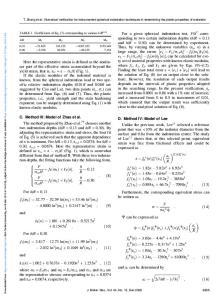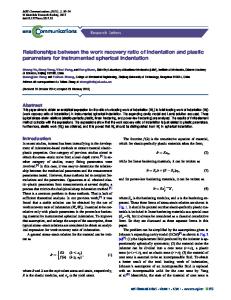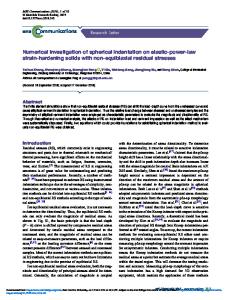Analysis of the spherical indentation cycle for elastic-perfectly plastic solids
- PDF / 329,449 Bytes
- 13 Pages / 612 x 792 pts (letter) Page_size
- 94 Downloads / 362 Views
A finite element analysis of frictionless indentation of an elastic–plastic half-space by a rigid sphere is presented and the deformation behavior during loading and unloading is examined in terms of the interference and elastic–plastic material properties. The analysis yields dimensionless constitutive relationships for the normal load, contact area, and mean contact pressure during loading for a wide range of material properties and interference ranging from the inception of yielding to the initiation of fully plastic deformation. The boundaries between elastic, elastic–plastic, and fully plastic deformation regimes are determined in terms of the interference, mean contact pressure, and reduced elastic modulus-to-yield strength ratio. Relationships for the hardness and associated interference versus elastic–plastic material properties and truncated contact radius are introduced, and the shape of the plastic zone and maximum equivalent plastic strain are interpreted in light of finite element results. The unloading response is examined to evaluate the validity of basic assumptions in traditional indentation approaches used to measure the hardness and reduced elastic modulus of materials. It is shown that knowledge of the deformation behavior under both loading and unloading conditions is essential for accurate determination of the true hardness and reduced elastic modulus. An iterative approach for determining the reduced elastic modulus, yield strength, and hardness from indentation experiments and finite element solutions is proposed as an alternative to the traditional method.
I. INTRODUCTION
The elastic–plastic indentation of a homogeneous halfspace by a rigid sphere is a fundamental problem in contact mechanics and of great importance in various material processes and mechanics applications, such as powder compaction, contact of rough surfaces, and thermal and electrical conductance. In powder compaction, the prediction of the global force-displacement behavior requires knowledge of the local indentation response between the particles.1 Likewise, analyses of contact deformation,2 surface adhesion,3 and static and dynamic friction4,5 of rough surfaces are based on single-asperity constitutive relationships of the contact parameters. The large number of studies published to date6–9 reflects the high level of interest on this subject. Indentation has been used since the beginning of the previous century to evaluate the plastic properties of metals.10 Conversely to traditional mechanical testing, indentation is localized and can be applied to either small
a)
Address all correspondence to this author. e-mail: [email protected] DOI: 10.1557/JMR.2004.0468 J. Mater. Res., Vol. 19, No. 12, Dec 2004
http://journals.cambridge.org
Downloaded: 16 Dec 2014
material samples or large machine parts and structural components. In recent years, advances in depth-sensing indentation techniques have provided a means for evaluating the mechanical properties of surface layers and thin films consisting of different mat
Data Loading...











